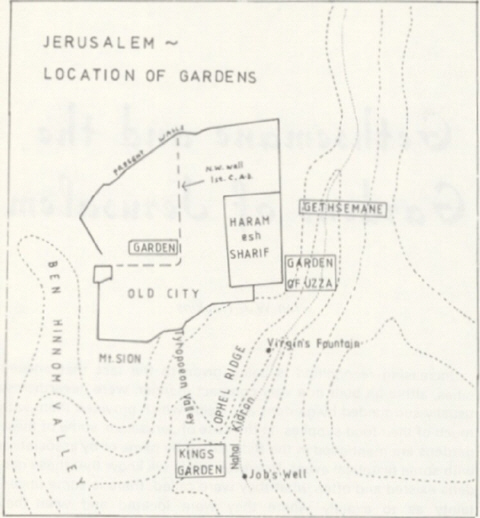Gethsemane and the Gardens of Jerusalem -- By: Ian W. J. Hopkins
Journal: Bible and Spade (First Run)
Volume: BSP 08:4 (Autumn 1979)
Article: Gethsemane and the Gardens of Jerusalem
Author: Ian W. J. Hopkins
BSP 8:3-4 (Summer-Autumn 1979) p. 113
Gethsemane and the Gardens of Jerusalem
[Ian Hopkins is the author of Jerusalem: A Study in Urban Geography, published by Baker Book House in 1970, as well as a number of articles in scholarly publications.]
Increasing recognition is being given to the fact that ancient cities, although built in a very compact manner, were nevertheless usually surrounded by gardens and fields which provided them with much of their food supplies. In the case of Jerusalem, some of these gardens are mentioned in the Bible either by name or by association with some historical event. However, while we know that these gardens existed and often what they were called, there is some uncertainty as to exactly where they were located and what they were like.
The Garden of Uzza
The first specific mention of a garden in Jerusalem in the Bible is in two references to a royal garden called the Garden of Uzza (Uzziah). In 2 Kings 21:18, we are informed that “Manasseh slept with his fathers and was buried in the garden of his own house, in the Garden of Uzza”. A few verses later it is recorded that Manasseh’s son Amon “was buried in his grave in the Garden of Uzza” (2 Kings 21:16). It is clear from these two references that this was a garden owned by the king and attached to his own house.
BSP 8:3-4 (Summer-Autumn 1979) p. 114

The location of the Garden of Uzza is consequently related to the question of the location of the royal household. The most recent opinions tend to locate the royal palaces just south of the temple platform (the present Haram esh-Sharif) on a narrow neck of land in the northern part of the Ophel ridge. It might seem that the Garden of Uzza should therefore be located in this area. Yet clearly since burials, even royal ones, would not normally be made within the city walls it cannot have been a palace courtyard garden. It is more likely to have been the garden which supplied the royal household with provisions and may be located either in the Kidron valley or perhaps even the Tyropoeon which lay between the ridge of Ophel which held the Old Testament city and the hill now known as Mt. Sion. The
BSP 8:3-4 (Summer-Autumn 1979) p. 115
Kidron valley has more water available and it is therefore most likely to have been the place for a royal garden.
There is, however, further information available on this garden. The fact that it was used for royal burials was the clue for George Adam Smith to link it with the statement in You must have a subscription and be logged in to read the entire article.
Click here to subscribe
